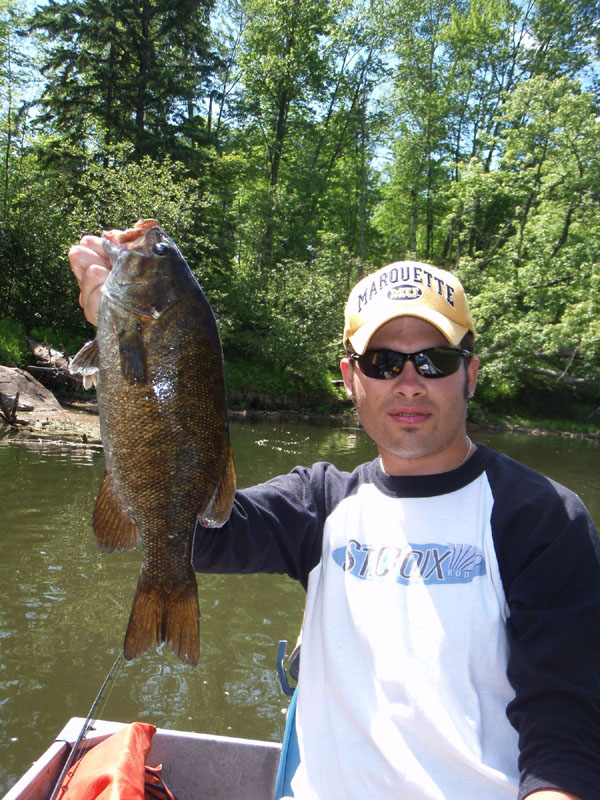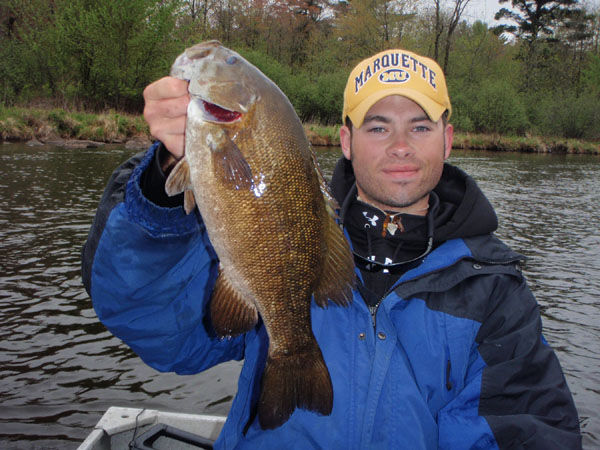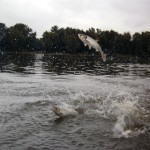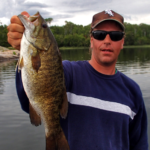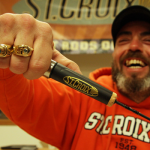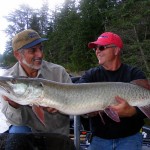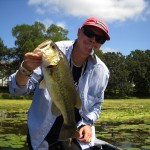By: Andrew Ragas
Ever since I knew how to handle a rod and reel I have frequently fished rivers throughout the Upper Midwest in search for anything that swims and is deemed as catchable. Growing up, flowing waters have served as my playground for learning about their diverse populations of fish species, and figuring out the methods and techniques in how to best catch them. In fact, most rivers today still serve as my training grounds in trying to better understand fish that come in all shapes and sizes. Of all bodies of water they are without question some of my favorite places to spend significant amounts of time at, especially during the heat of summer.
It wasn’t until my formative years during the beginning of high school when I saw firsthand of how great some rivers can be for smallmouth bass. Once I caught my first, I became hooked on it and like most other bronzeheads there was no looking back. My first smallmouth bass outings often took place confined to shore, and then quickly progressed to wading and exploring rivers and streams by foot, eventually wearing out several sets of waders during the decade since then. As I grew older with some grey hairs along the way, about mid-way through college, I took an enthusiastic interest in fishing the waters less traveled with my small 12 foot aluminum boat, “The Mud Puddler”. Float tripping flowing waters gives me the mentality that I am “Lewis” and my fishing partner is “Clark,” and this style of angling brings a huge excitement to me from the adventure and unique angling experience that comes with it.
By nature, smallmouth bass are originally known as a river fish, inhabitants of the shallow, hard-bottomed mid-gradient rivers of the northern United States. Back in the good ‘ole days, when life seemed less complicated and railroad expansion took place throughout the country, smallmouth bass were unconventionally introduced into new waterways along routes and their populations expanded as well. Since then, most states have conducted stocking programs to establish new fisheries which are now thriving. Nowadays smallmouth bass are present in rivers and lakes throughout several regions of the country, and serve as favorites for like-minded river anglers.
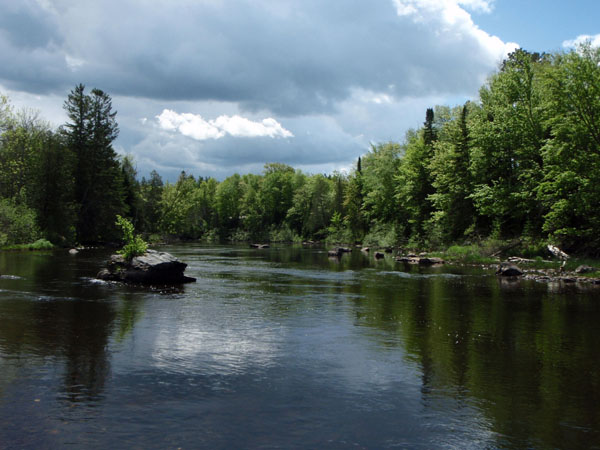
When and Where to Float
On an average summer of fishing, I make five to ten float trips for smallmouth bass down a few rivers that are scattered throughout the Upper Midwest. Each of these places I fish differs and contrasts from one another in several ways. For instance, some of these rivers possess clear water with high transparency while others have a dark tannic brown color and clarity that is less than a foot. Another distinguishing factor is how certain rivers have more current and cooler/cold water sources than others, and even differences in habitat as some are rocky, some are sandy, while others are somewhere in between. Meanwhile, other differences are seen in fish populations such as average sizes, growth rates, abundance, and catchability.
Knowing when and where to float all depends upon whether your river in question contains a productive smallmouth bass fishery along with an area for you to somehow access it. Fishing in Wisconsin’s Northwoods for half the year, I have the luxury of being able to catch smallmouth bass from majority of the navigable river systems that are all within driving distance from my home base.
Once you know that there is a viable fishery present in the river that is desired for smallmouth bass, the best way to know whether a float trip can be had is obviously if the river is able to support watercraft in order to allow a trouble-free drift. In my situation and the first thing I look for, the river must have some depth and be able to support a smaller boat with an outboard.
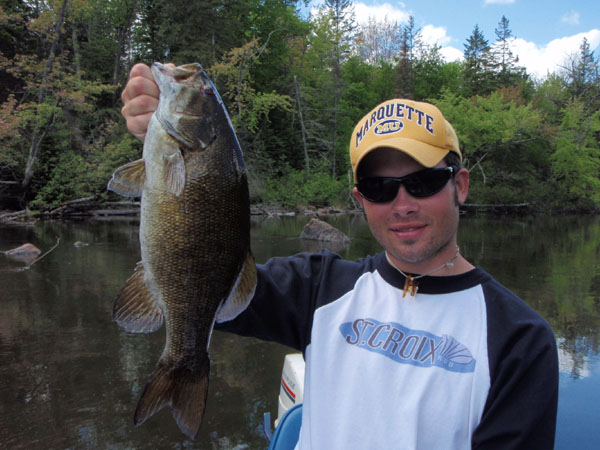
Choosing Your Water / Listen to Conditions
There are several variables that come into play for choosing the best water to fish.
Before I head out for my river adventures, the first thing I ever do before leaving home is to check the online stream flow gauges provided by the U.S. Geological Society. Their national and state website displays river heights, current flow levels, and yearly records of rainfall, floods, and more. This is an obvious procedure to do, providing that the river you want to float contains a monitoring station. If not, then I just go with the gut-feeling that water levels will be manageable and good enough for a float. Some days I have been lucky by blindly guessing current flow and water levels while on others the trips have led to failure because either the river was unknowingly flooded or too low to offer any navigability. Learn from some of my mistakes; don’t let failure like this and a wasted trip happen to you. Before you even think about fishing, always research and study beforehand.
Another factor that dictates in my selection of water to fish is if there are any public access areas such as boat landings, roadside parking, and take-in & take-out points at any points along the river. In most of the wooded and lake-littered regions I fish, a hand-held GPS tool as well as the car GPS have proven to be unreliable tools in locating access areas due to their sometimes poor detail in terrain and inabilities to receive signals and coordinates while located out in the middle of nowhere. Instead, I use county road maps, and a state gazetteer while driving and searching for my access areas. My Wisconsin gazetteer, a must-have tool for all backwoods fishermen, clearly identifies back roads, bridges, public access points, public boat landings and canoe launches, and even rapids and treacherous areas for river navigation. Best of all, it even distinguishes public from private land which is vital in searching for access areas. Paying attention to the detail brought forth by printed maps and legitimate cartography rather than relying on spotty technology is quite possibly the best means for searching and finding water to fish.
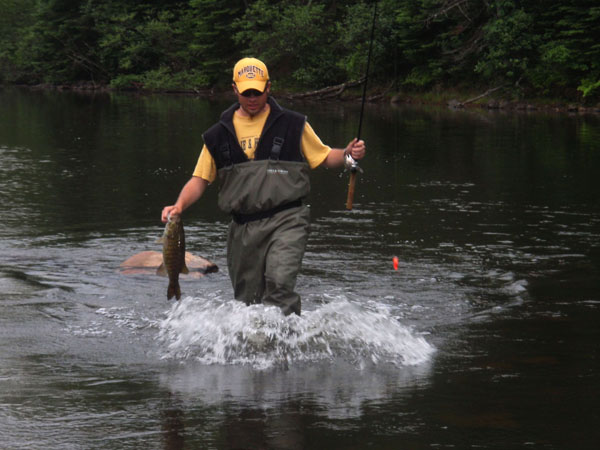
Besides fulfilling these homework obligations with figuring out water levels and finding access areas, there are several environmental factors that determine whether or not to things will be on task for a float trip. The checklist of factors is the following:
- Water Clarity: General Rule, the clearer in normal water conditions the better.
- Currents: Smallmouth bass are traditionally a current-related fish. In normal water levels slow to medium currents that have plenty of riffle runs are the norm.
- Navigability: The presence of boulders and other obstacles. You’re good to go as long as there aren’t hundreds of boat-busters exposed to the point of making boating treacherous, navigation impossible, and breaking a lower unit and cotter pins probable.
- Depth: Average depth needed for a small boat with short shaft outboard motor is a minimum of at least 2 feet. A river containing both shallow water habitat and deeper water refuge areas along with a channel that can be followed is money.
- Bottom Composition: A diverse habitat with a multitude of fish holding areas usually contains the best fishing in terms of quality. A river that has boulder, rock, gravel, sand, wood, and submerged vegetation is best for all.
- Gradient: Slow gradient usually contains poorest habitat, the deepest and most featureless water, and the warmest water temperatures. Fast gradient contains the best habitat and coolest water temperatures, but too strong of currents and poor for navigation & boat control. Mid gradient is suited the best and an overall good medium for all factors involved.
- Time of Day: Fish can be caught all day long providing that you fish during peak periods. However, during off-times of the year, more fish can be had at different times of the day; usually early or late depending upon season.
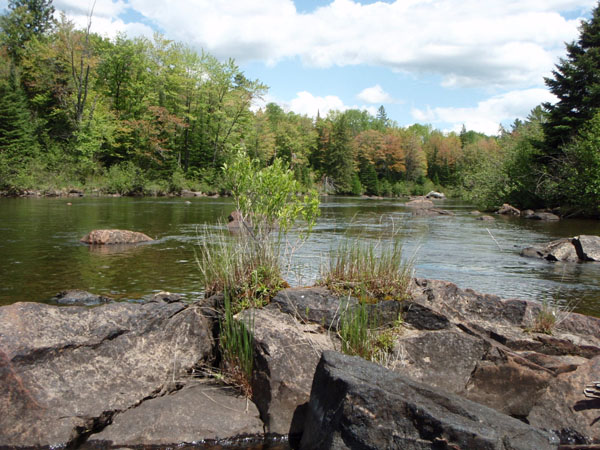
Fish Locations and Seasonal Movements
In terms of river environments, most of my float trips take place on rivers that possess a combination of both shallow and deeper water, and have a noticeable channel flowing through it. On most average river systems (whether large or small), navigation is had through the channel running through the middle and then anglers work for fish along the edges and either sides in the directions toward the riverbanks. For most float trips down smaller and mid-size rivers, this practice is most often followed.
Where I float the most in Wisconsin’s North Country, the most productive smallmouth bass fishing occurs from early May and lasts into September before fish eventually migrate downstream to deeper and larger sections of the river near their reservoirs for wintering. In mid-summer for instance, smallmouth bass are notorious for their migrating patterns and eventually transition from their shallow water habitats that were once best suited for spawning and early-season feeding.
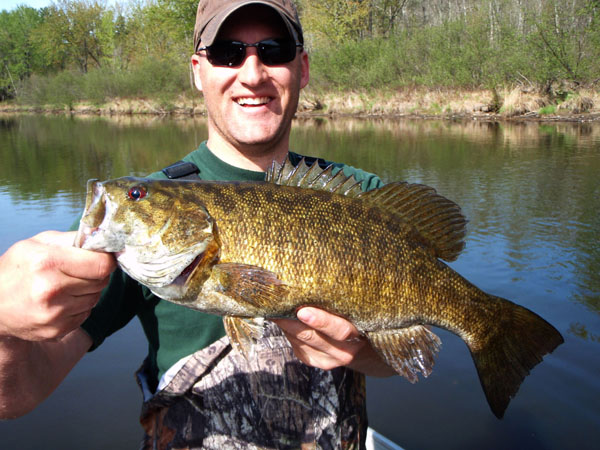
Ultimately fish disperse out to mid-river areas that hold structure and habitat such as hard-bottomed pools, deeper holes, rocks and mid-river boulders, riffles, moderate current, and channel edges. During warm-mid-summer days fish are more likely to be found utilizing areas with greater depth and current in order to escape from the external elements such as sunlight, warmer water temperatures, and in lower water levels and a near-stagnant flow which is an extremely common summertime scenario. In addition, areas with current and riffle runs are attractive to smallmouths because they contain rich amounts of dissolved oxygen.
Throughout much of summer it is important to take note that smallmouths will not be as concentrated in certain locations as they likely once were during the previous weeks during the pre-spawn, spawn, and spawning periods, and likely will be again during the late fall. From mid-summer until the first cold spell of fall it is extremely important to stay mobile while on your floats and to maximize water coverage. By covering large expanses of water the odds increase for better catches and greater numbers of encountered fish.
One last thing to take note of during the summertime months is to pay attention to peak periods. By angling definition, a peak period represents the best feeding activity and abundance of fish species. For summertime smallmouths, these events can be had when fish are found concentrated in number in a particular area, and are responding positively to conditions and what is being thrown at them. These scenarios can take place early or late in the day when fish might be more inclined to feed, or in areas of river where fish location might be dictated by water levels, water temperatures, clarity, and outside factors. For example, when water levels are low smallmouths will be schooling in deeper pools and channel areas. Another example is in warm weather where fish will seek riffles and areas of current to escape heat because these areas will contain the cooler and colder water. In essence, peak period fishing is all a biological game, all related to the positive moods of fish and their availability in known areas. Once fish are located and the conditions are right, it’s time to capitalize on them.
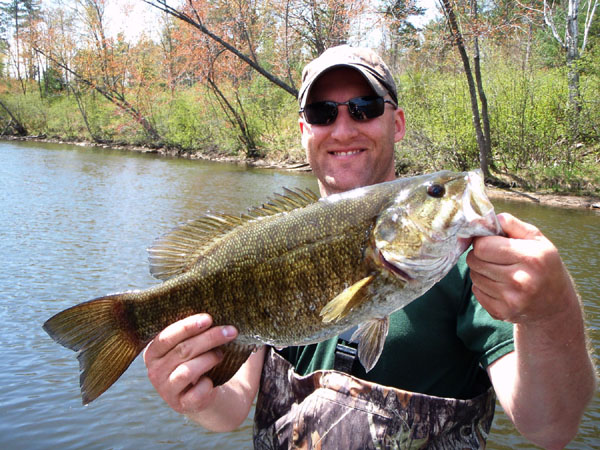
Gear and Tackle
There are several ways to tackle summertime smallmouths while float tripping. For mid-summer action, a variety of presentations will produce well for smallmouths. Below we examine some of my favorites from each lure category and describe when and where each is recommended to be fished.
SPINNERBAITS
Spinnerbaits are known as producers for active fish and serve best when making long drifts and covering water. Due to their abilities of performing well through both current and calm water, they are the most versatile lures I carry. They are nearly snag-proof, easy to fish, and bounce well off of rocks and other obstacles. Depending on current, water clarity, depth, and levels, it is wise to bring a variety of colors, blade types, and sizes ranging from ¼ oz. to as heavy as ½ oz. My absolute favorites are the Terminator T2 series in either a thumper style Colorado blade, or double bladed willow blades.
INLINE SPINNERS
Inlines are a traditional old-school approach to river fishing. They are quite possibly one of the most simplistic ways of catching fish from flowing water and they share many of the same characteristics as spinnerbaits. Inline spinners work best when covering water, and searching for actively feeding fish. Best of all, they can be fished EVERYWHERE! Favorites are Mepps Aglia and Sims Spinners with size 4 and 5 blades. Always bring a variety of colors because you never know which might be the hot color or style for that particular day.
CRANKBAITS
Crankbaits are a favorite for summertime smallmouths and are my best producers for when fish are utilizing mid-river channels, deeper holes with current, and slackwater areas in and around boulders and riffle runs. Crankbaits in crayfish pattern match the hatch extremely well in most river systems can be fished in any area imaginable. Favorites for grinding out fish are Rapala DT-4’s, Bandit 100 Series, and Mann’s Minuses especially when fish are in the shallows.
BUZZBAITS
Buzzbaits are great search baits, and work best when fish are on a surface feed. They work best when fish are using slackwater areas and pools with minimal current, and when fish are holding tight to downed wood and other shoreline cover. Favorites are 3/8 oz. Booyah in solid white and chartreuse.
TOPWATERS
Secondary to crankbaits and spinnerbaits, topwaters are excellent options when fish are putting on a surface feed, and active throughout the entire water column. They fare best during summertime heat and when water levels are low. Topwaters such as poppers, walkers, and propellers all have their time and place and should be a mainstay in anyone’s arsenal. Poppers such as the Rapala Skitter Pop and Heddon Jitterbug should be used in calm slack water pools and around eddies. Walkers are my favorites and are quite possibly the most versatile of the trio. They can be fished through moderate current and calm water areas, and active fish find them easily. Favorites are Rapala Skitterwalks and Heddon Zara Spooks. Lastly, I have taken a huge interest in prop style topwaters because they simply call the fish and are the loudest and most obnoxious of all. Like walkers, propeller topwaters such as the Rapala Skitter Prop work great in nearly all situations and shine especially during low light conditions.
GRUBS
Grubs are recommended when fish are less active, and holding near bottom. Certain grubs imitate minnows and baitfish while others display characteristics of being able to imitate crayfish. I always bring a package of grubs with me because they will usually work when nothing else does. Favorites are 5 inch Kalin’s Lunker Grubs rigged on 1/8 oz. Owner ultraheads or weighted worm hooks. Besides single tail grubs, twintails have become my best producers in recent years because they are capable of matching the profile of a bottom-scurrying crayfish more accurately. Twintails are nothing fancy and my favorite is the YUM brand.
CRAW TUBES
Of all baits imaginable for catching smallmouth bass, craw tubes in the 3 to 5 inch range such as the YUM brand are quite possibly the deadliest and most irresistible for fish. Craw tubes can be fished weedless with either a Texas rig, or a weighted worm hook such as an Owner or Charlie Brewer slider head style. Craw tubes are almost always a guaranteed catch for fish and work best when fish are feeding exclusively on crayfish. They can be fished everywhere but fare best when fish are confined to current breaks, eddies, and deep pools with rock bottom.
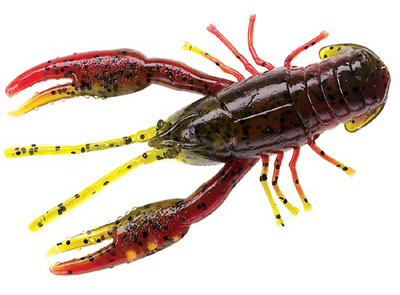
CREATURE BAITS
Last but not creature baits have their time and place and can load up on smallmouth bass. Like craw tubes, creatures are excellent crayfish imitators and bring some beef to the table when catching big fish is the objective. Creature baits are meant to be fished in snag-proof presentations along the bottom and work best in deeper pools, alongside of boulders, and slackwater areas on the downstream side of riffles. Favorites are 4 inch YUM Wooly Bugs and 4 inch Stankx Mudbugz. Also included in this category are hula styled grubs, a skirted plastic that features a twin tail. Never come to the water without a package of 5 inch Chompers and 4 inch YUM Gonzo Grubs.
As far as rods and reels are concerned, old time favorites is medium to medium-heavy action spinning gear, along with a baitcaster. In addition, fly fishing has become an effective means for scoring fish when wading becomes a secondary option during the float and if trying to efficiently fish specific areas.
Due to fishing out of a smaller craft and wanting to stay comfortable, I usually limit myself to two spinning and two baitcasting set-ups on each trip. If also in the mood, I will bring my 8WT fly rod which collapses and stores easily.
On any given float trip, it is wise to use a variety of presentations. Likewise, it is even wiser to limit your gear selection by only taking what you need as the watercraft is usually small, and the fishing is to be kept simplistic.
Boats and Watercraft
Depending on the type of river you fish, the best craft for smallmouth bass fishing can be a high powered bass boat, an aluminum semi-V, jon boat, canoe, or even a kayak. Most traditional small river boats, however, are 12 to 16 foot aluminum semi-V and flat bottomed jon boats. For the all-day comfort, durability, maximum horsepower and weight capacities, ability to clear over shallow depths and stable casting platforms, I prefer fishing from small aluminum boats.
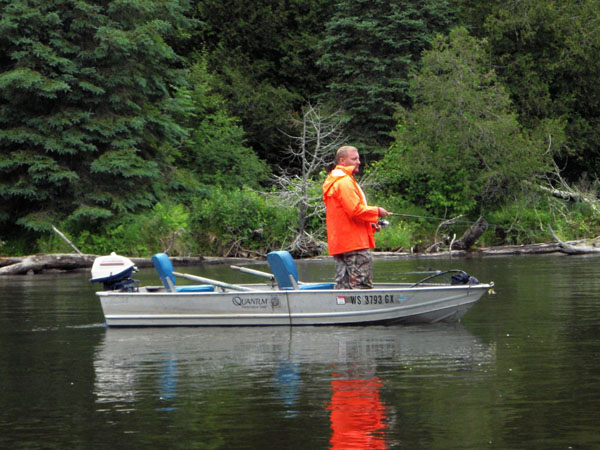
The stability and light weights of small aluminum boats make them ideal for river fishing. Many rivers in my neck of the woods lack developed boat landings and modernized access areas. This problem is easily defeated with the aid from my fishing partners as we can easily lift the boat off from the trailer, slide it through the woods and then drop it into the water. Following that, we load up the gear, strap on the waders, and away we float.
Small river anglers tend to rig their aluminum boats differently. I have seen boats that have been bare bones without any accessories, and I have seen others that have everything from customized casting decks, pedestal seats, bow-mount trolling motors, GPS, jet outboards, and more. Since this style of fishing is rather simplistic, boats do not require much in terms of rigging unless you choose to build the ultimate dream platform.
For your small river rig, the necessities for navigation are a small short shaft outboard. Smaller aluminum boats have ratings for up to 10 horsepower while some that are larger and a bit heavier have ratings for up to 25 horsepower. My suggestion is to go with the maximum horsepower capacity that your boat can handle. Believe it or not, small gas outboards are a necessity for river fishing if the river is both large and deep enough to support them. They prove beneficial in situations when motoring for miles upstream back to the access area, and are able to fight against the current far easier than paddling manually (such as a kayak or canoe).
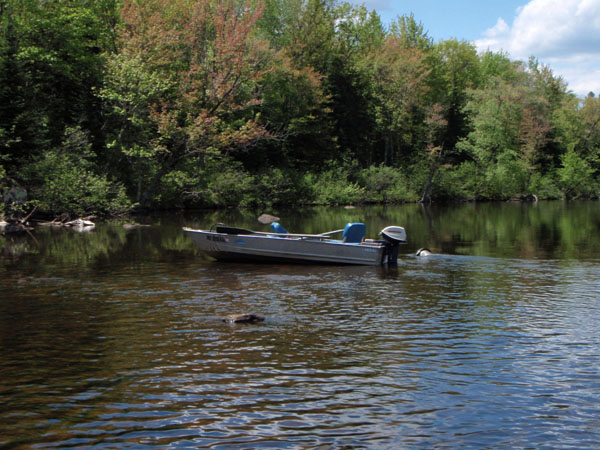
In addition to gas outboards, other accessories worth considering are oars and an electric motor. Oars are beneficial for operating a controlled downstream drift and enables anglers to fish with stealth and quietly hold position. In addition, an electric transom mount trolling motor may be used to further improve boat positioning, and the speed and accuracy of the drift. In some situations, bow mount trolling motors might also be used but they are not essential unless the boat features a front casting deck that is frequently used.
Besides motor options, other accessories worth mentioning are fish locators. In many small river environments, fish locators are a necessity for finding channels and the deeper holes that fish will sometimes be relating to. Small river anglers commonly use portable sonar units that adhere to the rear of the boat while others use permanently mounted graphs that are more accurate and reliable. Some anglers might even use GPS and high end side imaging sonar systems but in my opinion a basic unit that displays depth, water temperature, and distinguishes bottom contour is all that is needed.
The boat in particular I fish from is a small 12 foot aluminum semi-V that gets trailered around to several of the hard to access lakes and rivers in my area. This little rig features everything such as a short shaft 6 horse Evinrude outboard, a 45 lb. thrust MinnKota Traxxis electric motor, a set of oars, a basic fish locator, and even padded seats. Ultimately my choice in watercraft suits my style of fishing and the type of fishing I do is reflective of it.
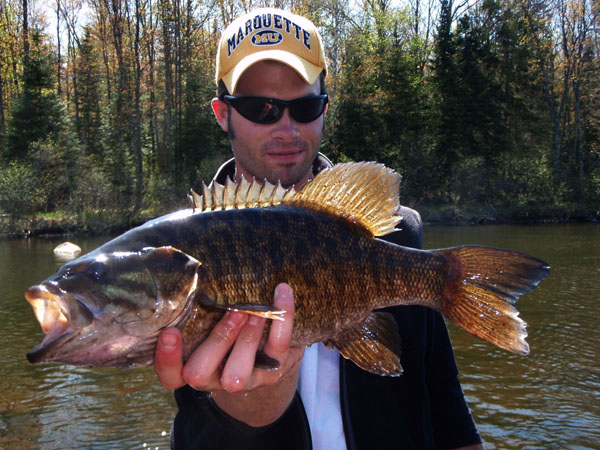
Boat Positioning Techniques
Boat positioning is the most critical factor in dictating the productiveness and success of your float. As already mentioned, it is important to consider small outboards, electric trolling motors, and oars as precise boat control enables anglers to have the best casting angles, accurate drifts, more catches, and better success. However, there is one tool that I have yet to mention and that is a set of anchors.
Anchors are the most important tools in my boat. An anchor allows the boat to hold steady position, and along with their aid certain spots can be fished effectively and efficiently. Most common river anchors feature three arms and come in 15 and 20 lb. sizes. On most float trips it is common for one anchor to be released at the rear while the other to be released up front. Dual anchoring prevents the boat from shifting caused by current push, an annoyance for achieving good casting angles.
As far as formally positioning the boat is concerned, we fish both the upstream and downstream sides of riffles, boulders, deep holes, rocks, and anything else capable of rearing fish. I’ve always heard the notion that you should only fish the downstream ends by casting upstream because fish are always facing upstream. That is all a myth. To maximize the full potential of each area fished it is important to work each end of a certain spot equally hard because fish always respond differently to current and the placement of baits.
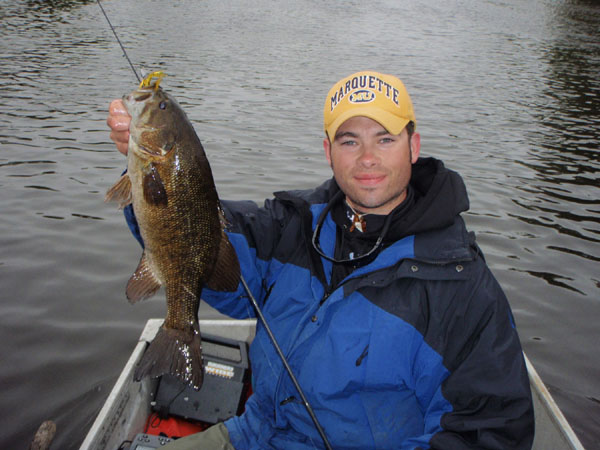
A river flows through it
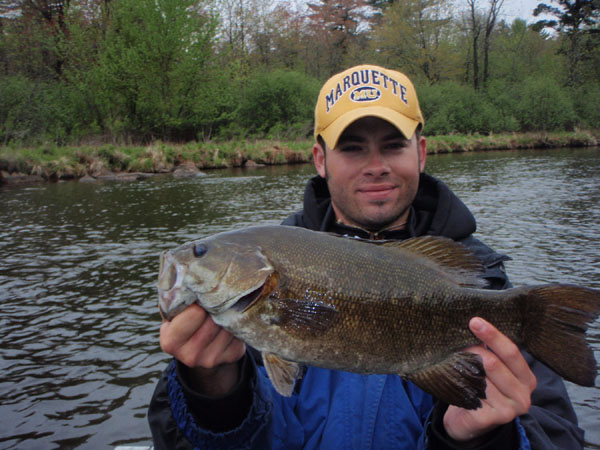
Many anglers overlook river bass fishing as a viable option for catching fish as they focus more on shore fishing small ponds, or running and gunning large lakes with fast boats. With the tremendous amount of smaller navigable rivers and streams scattered throughout the Upper Midwest, there are several opportunities for catching fish from these areas. Most of which are less traveled, rarely accessed, and seldom receive angling pressure.
Like Lewis & Clark, the mentality of each trip I take is to float downstream and explore as much water as I possibly can until it is take-out time. Fishing a river often brings out the possibilities for numbers days, big fish days, or just a mixed bag of good multi-species action.
What’s so great about fishing small rivers you may ask? Is it the sound of water which fuels life, or the abundance of smallmouth bass being present in the places less traveled? Being in the presence of nature and taking a break from fishing the big water is what compels me to undertake such adventures.
Ever wonder what lies around that bend? I’m still wondering for myself as I still have miles upon miles of smallmouth loaded water left to cover. To my surprise, I still have more than enough to last me a lifetime of continued explorations.
